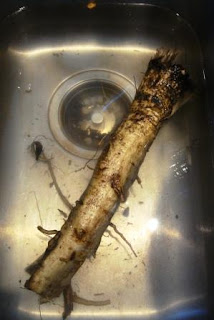
I feel like I am in a race against time. Today we were finally able to finish thinning the apricots - it had to be done. The fruit have grown so fast in the two weeks since we started the thinning job (as you can see above), that it could not be delayed any further without risking bruises and damage to the apricots. I am sure that the urgency to get jobs done on the farm will continue to increase as the months progress and our fields start gearing into high production.
In the meantime, I my roomates and I are enjoying the organic products available to us on the farm. I must admit that in comparison to most people I would consider myself to be very knowledgeable when it comes to the uses and origins of most foods and their ingredients. However, my knowledge is being put to shame on the farm. Every day I am being exposed to new foods.

Garlic scapes: these are the immature flower stalks of our garlic variety and can be used in cooking like garlic but with a milder flavour.
 Kefir: Kirsten is the fermenting queen. This is her kefir jar containing the kefir mother (a large bulbous looking mass with a thick gelatenous consistency), fermented goats milk and the separated whey. She harvests the kefir every two days and then feeds the bacteria mother fresh milk to keep is alive and happy. Kirsten and I are sharing the products of this wonderful bacteria, and so every two days I find a new jar of kefir in my section of the fridge. Being lactose intolerant, the bacteria takes care of all the lactose in the milk on my behalf. The consistency of the kefir is like liquid yogurt. I use it in all dishes like milk or yogurt - I add some stevia and cinnamon for a dessert or I add some tablespoons to my idian curry dishes to make them milder and creamier.
Kefir: Kirsten is the fermenting queen. This is her kefir jar containing the kefir mother (a large bulbous looking mass with a thick gelatenous consistency), fermented goats milk and the separated whey. She harvests the kefir every two days and then feeds the bacteria mother fresh milk to keep is alive and happy. Kirsten and I are sharing the products of this wonderful bacteria, and so every two days I find a new jar of kefir in my section of the fridge. Being lactose intolerant, the bacteria takes care of all the lactose in the milk on my behalf. The consistency of the kefir is like liquid yogurt. I use it in all dishes like milk or yogurt - I add some stevia and cinnamon for a dessert or I add some tablespoons to my idian curry dishes to make them milder and creamier.
Burdock root: Burdock is native to most parts is seems, and there is certainly enough of it here. I am under the impression that burdock is considered by many 'a poor man's food', but food is food right? On the farm I have seen the root sliced up and cooked or sauted like other root vegetables and served with different sauces.

Honey: Living in an agricultural valley, what we cannot grow here tends to be easily available. Honey included. Orchard Blossom is a honey distributor up the road. If you bring your own container, you can get liquid honey at $6.50 CAD a kilogram - for those of you who are not avid honey buyers, that is a very good price. I have already filled four jars on behalf of some Vancouver friends of mine which they are anxiously awaiting to receive.
You may be wondering then what a typical day of meals would entail on the farm living on the low budget that we are living on. Right now, the farm is certainly still in early production mode, but we still have enough food to see us through our workday. Generally, each day we are currently eating salad, mixed greens, eggs, kefir, apples, and squash. For our grains, sugars and legumes we put an order into Discovery Organics to get bulk (and farm) prices.
I am eager to see what eating organically for the next six months does to my general health, energy levels and overall mood. Good things I hope!
No comments:
Post a Comment